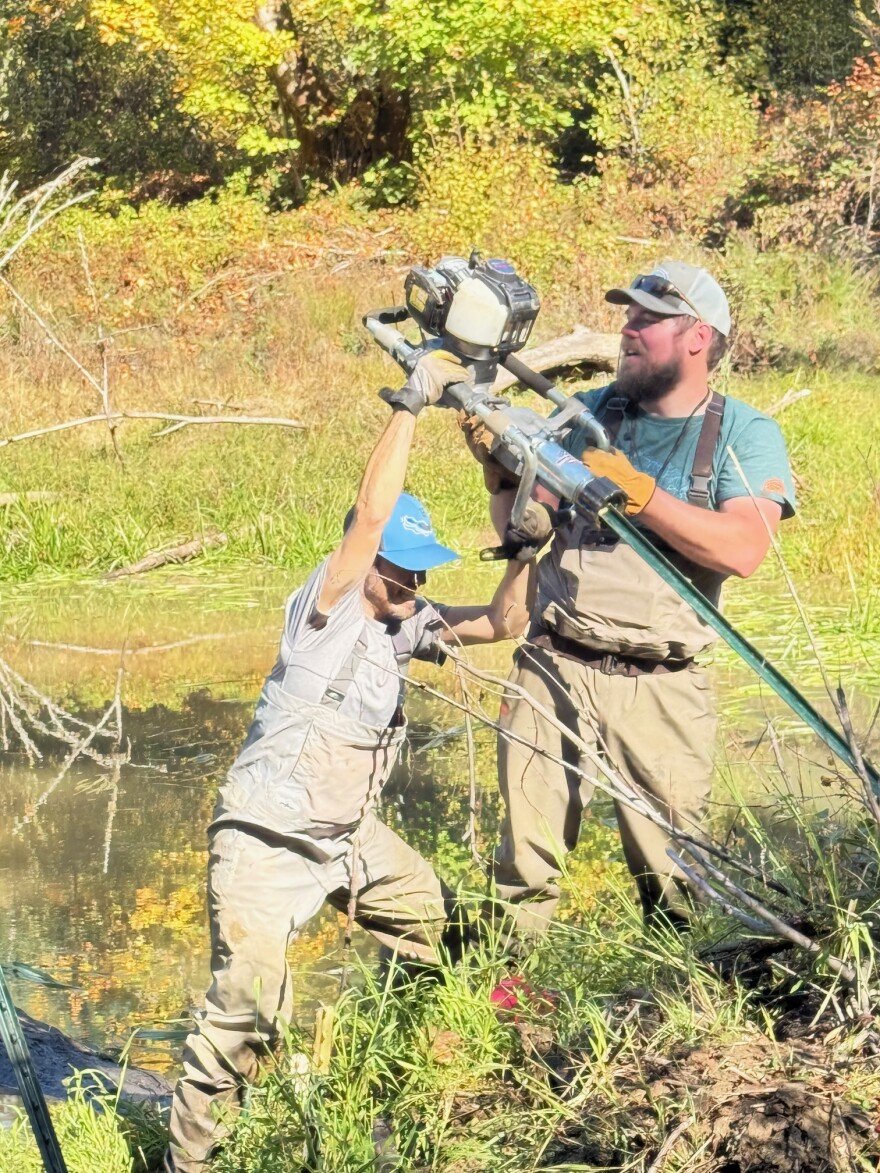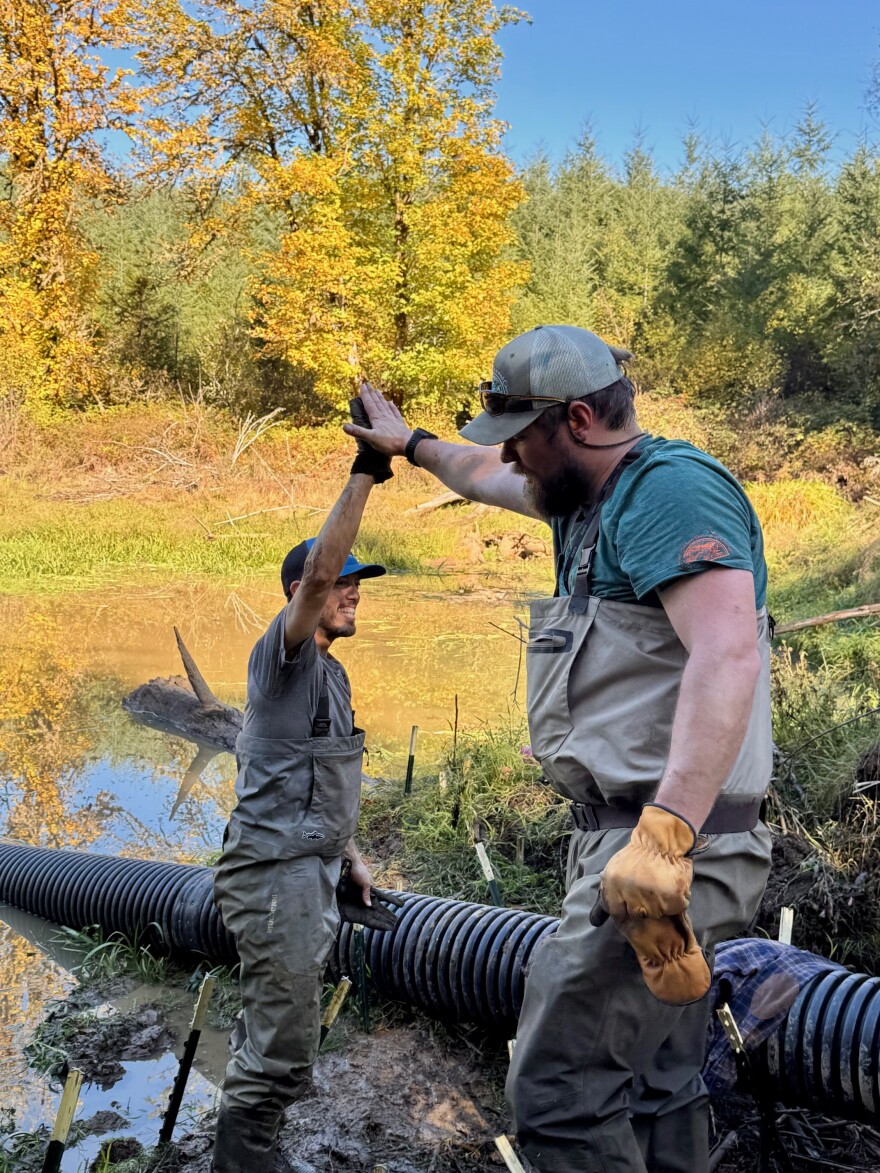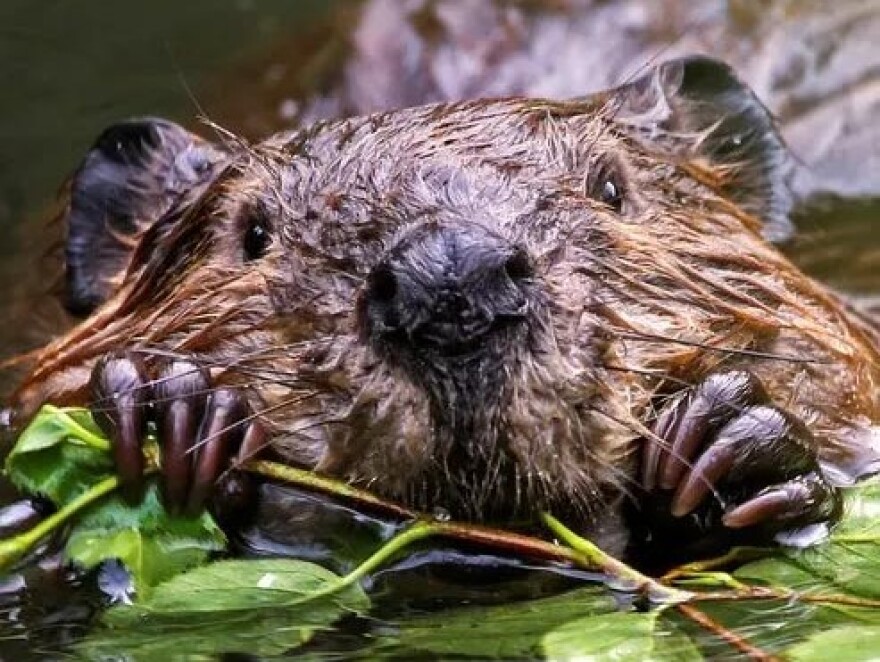Beavers are making a comeback in Oregon. No, we’re not talking about the beleaguered OSU football team—but the fuzzy, semiaquatic rodent species: the North American beaver.
Beavers are nature’s ultimate “ecosystem engineers,” but the structures they build aren’t always embraced by humans because of threats of flooding or other damage. Now, conservation groups are helping people learn how to co-exist with beavers.
The Mid-Willamette Beaver Partnership is a regional group of partners that works to promote healthy landscapes and communities by restoring and enhancing beaver habitat; addressing beaver-human conflicts with alternatives to trapping; and showcasing positive relationships between humans and beavers.
Where the wild things are
At a remote site outside of Sweet Home, a beaten trail leads to a marshy pond lined with pussy willows. Two men are sloshing through the water in chest waders.
“We are on private timberland in a remote area called Berlin," said Tyrell Styhl, Ecological Projects Coordinator for the South Santiam Watershed Council. "It's about equal distance between Sweet Home and Lebanon at the foothills of the West Cascade Mountains.”
Styhl gestures to a long structure of earth and sticks.
“It’s an historic beaver dam. It's really old," he explained. "A legacy beaver dam, maybe? It's been here for decades. It's about 125-150 ft long, 6 to 7 ft tall, and it retains about a 3/4 to 1 acre pond behind it.”

The other fellow knee-deep in water is Jean-Paul Zagarola, a senior program manager at Bonneville Environmental Foundation.
“I’ve been on a mission, I guess you could say, for the last six years now, trying to make it easier to restore habitat for beavers and to coexist with beavers.”
Zagarola said his work started with the Mid-Willamette Beaver Partnership and has now expanded to programs elsewhere in Oregon, as well as Washington.
“I don't know that there's an ecosystem engineer out there that provides as many benefits to both the ecosystem they're creating or supporting-- but also to human communities and human systems,” he said. “Their role is a ‘keystone species.’”
A keystone species is a plant or animal that plays a crucial and unique role in the way an ecosystem functions. Without this species, the ecosystem could collapse. Besides beavers, other North American keystone species include sharks, grizzly bears and bees.
According to the National Center for Biotechnology Information, the current beaver population is around 10% of what it was historically. But thanks to conservation work, beaver numbers are improving. Styhl said a big part of his work is educating people about what beavers do for us.
“The services that beavers provide to the habitat is it creates this retained water that is held in a system longer than if the water was just flowing through a stream,” he said.

In addition to water retention and creating habitat for bird and mammal diversity, Styhl said beavers can also help reduce wildfire risks.
“Areas that have substantial beaver wetlands and beaver ponds–these drainages have showed that the riparian areas are being saved from wildfire where wildfire comes in," he said. "It’ll burn up to the beaver wetland and not be able to make it in because of all that retained water.”
When humans and beavers collide
But beaver dams can also pose a risk to people living downstream. Styhl said last winter, a 30-foot section of this dam breached, sending a wall of water towards homes just down the creek.
Dave Sims and his family live in one of those homes, only about 750 feet downstream from the beaver pond.
“It was about 4:30 a.m., maybe 4:45 in the morning, on Christmas Eve morning,” Sims recalled. “The two girls come running into our bedroom hollering ‘Wake up! Wake up! We're flooding! We're flooding!’ and I kind of rolled over and thought ‘we're not flooding we live on a hill!’ and my granddaughter was like ‘Grandpa, grandpa you got to get up!’”
Sims, who works as a commercial fisherman in Alaska, said he got up and quickly heard a roaring sound. He shined a spotlight outside and there was water almost up to the windows. He said it was scary.
“There was logs racing by, there was water running around both ends of my home,” he said.
His mind was racing. Then it occurred to him that the beaver dam above his home had burst.
Based upon the size of the pond in winter, and the height of the beaver dam at the time, it’s estimated roughly 2 million gallons of water tore through the breach and in seconds, engulfed Sims’ house.
In the aftermath, Sims guessed it probably “took 100 man-hours” to get things cleaned up. All this, during the height of the holiday season.
“I don't think Christmas was very much on our minds at that point,” he said. “We were all pretty shook up.”
As the water receded, Sims got in touch with the private timber company responsible for the land and the dam. He said they put the wheels in motion to repair the beaver dam with the help of ecologists like Styhl and Zagarola. Unlike some landowners with beaver issues, Sims understands the need to coexist.
“You're not going to stop the beavers,” he said. “So, the best thing you can do is to help the beavers, right? If you give them a backbone to build their dam on, the dam is just going to be better and stronger. So, I think the beavers are gonna be happy and I'm going to be happy.”
Building better beaver structures, dam-it!
Back at the spot where the beaver dam breached, Zagarola and Styhl are pounding in rebar posts.

“The beavers have been busy all year and have actually started to rebuild up the dam," Styhl said. "It’s about half the height of the original dam but we are concerned that there could be another breach at this point.”
Styhl noted last winter’s dam breach followed a particularly rainy season. "Beavers are amazing builders,” he said. “But they can’t control the weather."
Recently, they installed a pond leveler here. Styhl said it's essentially a bathtub drain for the pond.
"It's about a 40-foot-long corrugated pipe that's 12 inches in diameter," Styhl said. "We set the outlet of the pipe on top of the dam and that height of the outlet controls the height of the pond.”
So now, no matter how high the beavers build their dam, the leveler will control how much water is retained behind it.
The Hamilton Creek sub-basin is a hot spot for beavers in the South Santiam Watershed. Beavers love to dine on the bark and fleshy bits of willow branches. “They kind of eat it like a piece of corn on the cob,” Styhl said.
Beavers are nocturnal creatures, probably to avoid predators. While they can sometimes be seen in the daytime, most beaver work is done from dusk to dawn. Still, there are plenty of signs that beavers are amongst us.
On the edge of the pond, Zagarola points out something called a “bank den” where the beavers have been laying low.

“They'll pile sticks up on it like you can see here and they will have an entrance that's underwater,” Zagarola said. “And they usually have an emergency exit too, in case there is some sort of predator that is trying to come in one exit or entrance, they can exit through another entrance. Brilliant, right?”
And Styhl said there’s more proof of life. “I see the fresh beaver chew,” he said, referring to the distinctive teeth marks left on tree branches by beavers . “There's some fresh beaver chew downstream that every time I've come up here, there's been more and more.”
Styhl said he’s met five or 10 beavers face-to-face in his lifetime, and has also heard the tell-tale slap of a beaver’s tail in water. It’s how they warn that danger is near.
Always at the ready, Styhl’s 4-year old black lab, Nyx, bounds into the pond to fetch a stick.
“She's an honorary staff member of the South Santiam Watershed Council as our water quality consultant,” said Styhl.
Together, Styhl and Zagarola pound the last two 12-foot posts into the side of the beaver dam. Huffing and puffing, they agree this dam isn’t going anywhere, anytime soon.
“That’s for dam sure,” they laughed.




